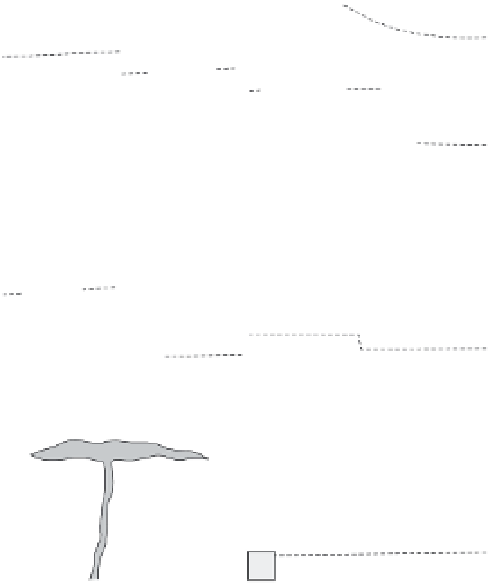Geology Reference
In-Depth Information
events that can be examined. As a result, the
paleoseismic records in trenches of large thrust or
normal faults are commonly limited to one or two
events (Rubin
et al.
, 1998; Lavé
et al.
, 2005).
Offset strata due to dip-slip faulting can
present additional challenges that may not be
present with strike-slip faults. Stratigraphy that
is displaced by strike-slip faults is translated
horizontally into new positions where the strata
on both sides of the fault are commonly
preserved. Thus, more sediments can accumulate
above the displaced strata and piercing points
recorded by the older strata will be preserved.
On the other hand, when dip-slip faulting
occurs, the strata on one side of a fault are
upthrown with respect to the opposite side. In
theory, the offset of the strata on opposite
sides of the fault records the magnitude of
displacement. Unfortunately for paleoseis-
mologists, strata on the upthrown block are
typically subjected to subaerial erosion.
Consequently, the specific stratal layers that
could define the offset precisely can be eroded
away (Machette
et al.
, 1992a), such that
reconstruction of past displacements becomes
considerably more difficult.
In order to reconstruct the history of offset
that is recorded by strata within a trench,
stratigraphic and structural relationships
revealed in the walls have to be carefully
interpreted. One goal should be to reconstruct
the direction of slip in previous earthquakes.
Consequently, indicators of the slip direction,
such as striae, slickensides on the fault plane,
fold axes of deformed strata, or the displacement
of piercing points, should be sought. As with
traditional structural geological studies, cross-
cutting relationships can provide unambiguous
evidence of past deformation (Fig. 6.4). For
example, if older strata are cut by a fault, but
overlying younger strata are continuous across
the trace of the fault, an earthquake is interpreted
to have occurred between deposition of the
youngest strata that are cut by the fault and
the oldest strata that are not displaced by it
(Fig. 6.4A). If these strata can be dated,
they provide bracketing ages on the faulting
event. Progressively larger structural offsets
of stratigraphic horizons farther beneath an
Stratigraphic Indices of Faulting
draping and overlap
of fault scarp
unfaulted strata
overlap unconformity
younger
offsets
fault plane
eroded
fault scarp
older overlap
unconformity
fault plane
older
offsets
A
B
colluvial wedge or
landslide debris across
fault scarp
fissure filled
with colluvium
eroded
fault scarp
fault plane
fault plane
D
C
folding due to shaking
& liquefaction
draping strata
sand blow
injection
dike
offset strata
E
F
Fig. 6.4
Stratigraphic indicators of past faulting
events.
A. Strata offset across a fault are beveled by an
unconformity and overlain by undisturbed strata. The
unconformity developed after the last earthquake. The
amount of displacement increases downward. The two
different amounts of offset of strata and the presence
of an older offset unconformity provide evidence for
a previous earthquake. B. If the topography across a
faulted surface is incompletely beveled off, succeeding
strata will drape across the eroded fault scarp. They
will be unbroken, but may appear deformed due to the
topography on which they were deposited. Commonly,
they will show thickening above the downthrown fault
block. C. Similar to B, but with a colluvial wedge
derived from erosion of the upthrown block.
D. Fissures that open along a fault plane are typically
filled with colluvial material shortly after faulting.
E. Injection dikes in the subsurface and sand blows
or sand volcanoes on the surface provide evidence for
past earthquakes. The age of the youngest strata cut
by the dikes or underlying the sand blow provides a
maximum age on the faulting. F. Liquefaction due to
shaking can cause folding of weakly consolidated
sediments near or at the surface. The age of the
deformed beds provides a lower limit on the time of
the earthquake that deformed them. Modified after
Allen (1986).



































































































































